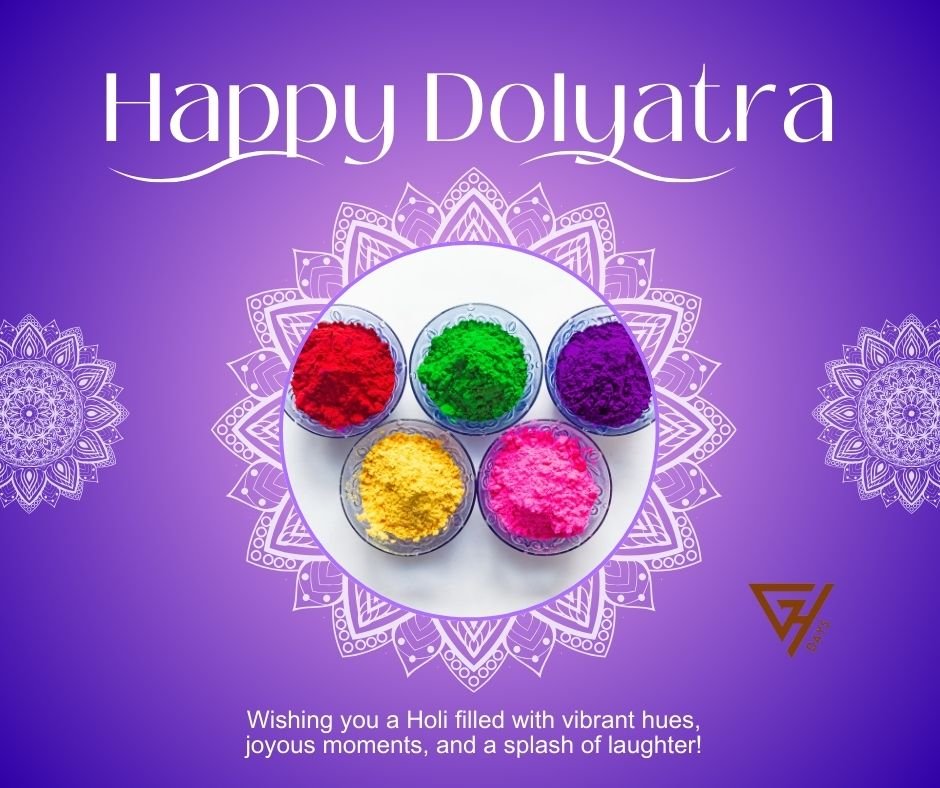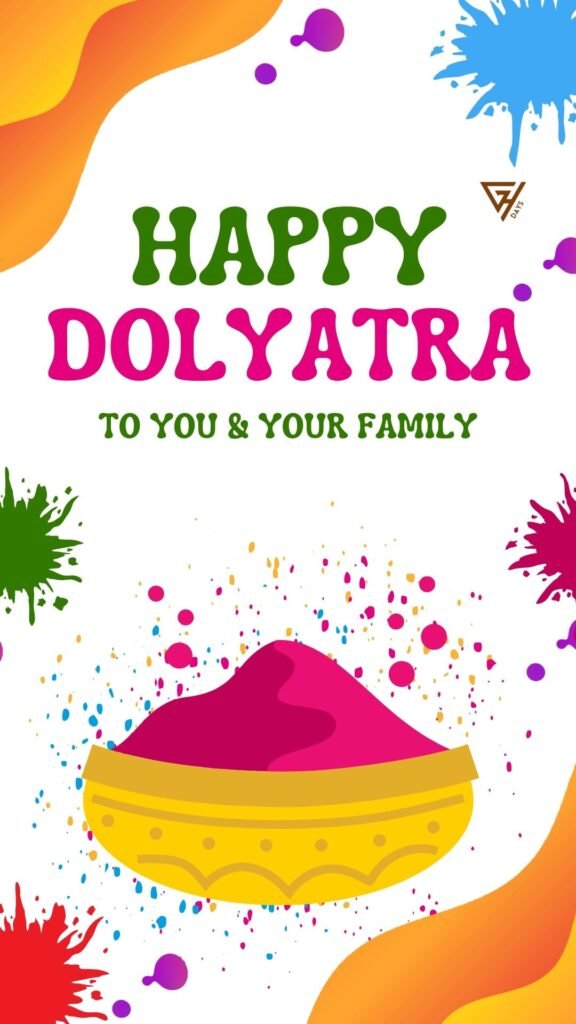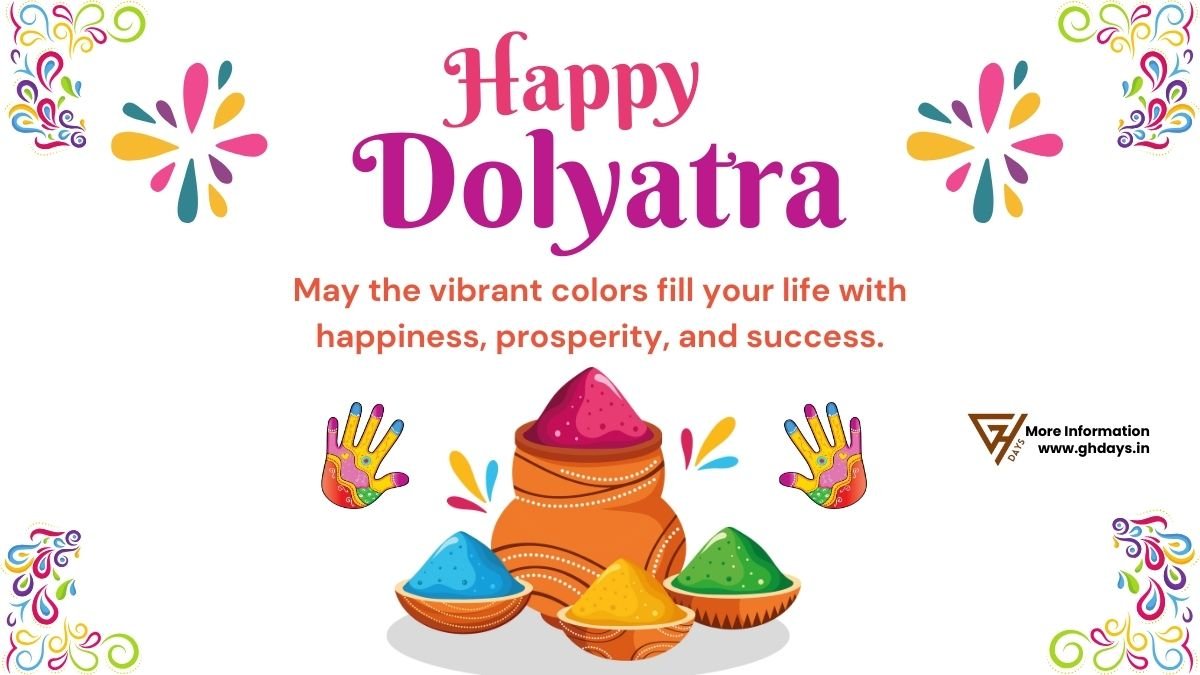Dolyatra Date 2025 – Festival of Colors: A Vibrant Celebration of Unity and Joy – GHdays
Dolyatra Date: Dolyatra, also known as the Festival of Colors, is a vibrant and joyous celebration that takes place every year in India. In 2025, Dolyatra falls on Friday, March 14th, and people from all walks of life will come together to participate in this colorful extravaganza. Celebrate the arrival of spring and the triumph of good over evil by immersing yourself in a riot of colors, laughter, and joy. Join the worldwide celebration of unity, love, and happiness. Don’t miss out on this unforgettable festival on Friday, March 14th, 2025.
Dolyatra Date 2025: 14th March, Friday
Dolyatra Date 2025 Overview
| Festival Name | Dolyatra |
| Also Known as | Dola Jatra, Dol Purnima |
| Observed by | Hindus of Bangladesh and the Indian state of West Bengal, Odisha and Assam |
| Type | Religious, cultural, spring festival |
| Celebrations | Spraying color dye, playing with coloured powder, dancing, greetings, festival delicacies |
| Date | Phalguna Purnima |
| Holiday Type | Restricted Holiday |
| Related Topic | Click here |
Dolyatra Date 2025 Details
Dolyatra Date 2025: The Festival of Colors
Dolyatra, also known as the Festival of Colors, is a vibrant and joyous celebration that takes place every year in India. In 2025, Dolyatra falls on Friday, March 14th, and people from all walks of life will come together to participate in this colorful extravaganza.
The festival marks the arrival of spring and the triumph of good over evil. It is a time when people let go of their inhibitions and immerse themselves in the spirit of fun and frolic. The highlight of Dolyatra is the throwing of colored powders and water at each other, creating a kaleidoscope of colors and laughter.
On this day, friends and family gather to celebrate, exchange greetings, and indulge in traditional sweets and delicacies. The air is filled with the sound of music, drums, and laughter as people dance and sing together. It is a day when social barriers are forgotten, and everyone is equal in the sea of colors.
Dolyatra is not just limited to India; it has gained popularity worldwide, with people from different cultures and backgrounds embracing the festival. It is a celebration of unity, love, and happiness, and it brings people closer together.
As the sun sets, the festivities continue with bonfires known as Holika Dahan. People gather around the fire, sing religious hymns, and offer prayers. It is believed that the fire cleanses and purifies the soul, marking the end of winter and the beginning of a new season.
Whether you are in India or anywhere else in the world, Dolyatra is a festival that should not be missed. So mark your calendars for Friday, March 14th, 2025, and get ready to immerse yourself in a riot of colors, laughter, and joy.
When is Dolyatra in India 2025?
| Dolyatra Date 2023 | 07 March |
| Dolyatra Date 2024 | 25 March |
| Dolyatra Date 2025 | 14 March |
| Dolyatra Date 2026 | 03 March |
| Dolyatra Date 2027 | 22 March |
| Dolyatra Date 2028 | 11 March |
| Dolyatra Date 2029 | 01 March |
History of Dolyatra Festival
In Hindu mythology, the festival of Dolyatra is deeply intertwined with a multitude of ancient tales. Among these, one well-known legend recounts the saga of Prahlada and Holika. Prahlada, a devout follower of Lord Vishnu, found himself at odds with his father, Hiranyakashipu, a malevolent demon king intent on eradicating Prahlada for his religious dedication.
Holika, the sister of Hiranyakashipu, possessed a special ability granting her immunity to fire. Deceptively, she lured Prahlada to sit on her lap and entered a blazing inferno. However, through unwavering faith and divine protection, Prahlada emerged unscathed while Holika met her demise in the flames. This tale serves as a poignant symbol of the triumph of righteousness over malevolence and is commemorated as Holika Dahan, observed on the eve of Dolyatra.
Rituals and Traditions of Dolyatra
Dolyatra commences with the vibrant ritual of Holika Dahan, marking the start of this joyous two-day festival. In a harmonious union, individuals converge around the crackling warmth of a bonfire, engaging in heartfelt prayers and presenting coconuts and various offerings as gestures to invoke divine blessings and safeguard against malevolent forces. The subsequent day unfolds as the pinnacle of Dolyatra’s festivities.
Enthusiastic revelers congregate in open arenas, bustling streets, and sanctified temples, equipped with an arsenal of vividly pigmented powders known as gulal and playful water-filled balloons named pichkaris. The ambiance resonates with jubilant echoes of laughter, melodic tunes, and spirited cries of “Holi Hai!” as participants gleefully adorn each other with hues and playfully douse one another with refreshing splashes of water. Additionally, delectable traditional confections such as gujiyas and malpuas are meticulously crafted and generously distributed amongst cherished companions and relatives.
Cultural Significance of Dolyatra
Dolyatra transcends being merely a festival characterized by the splendor of colors; it embodies profound cultural importance. Acting as a unifying force, it transcends divisions rooted in caste, faith, or societal standing. This celebration serves to foster solidarity, affection, and the spirit of absolution. Participants set aside their disparities, converging to commemorate the exuberance of existence. Additionally, Dolyatra heralds the onset of spring, embodying nature’s rebirth and the victory of righteousness over malevolence. The lively spectrum of colors utilized in this festivity symbolizes life’s myriad shades and society’s rich tapestry of diversity.
Celebrations of Dolyatra Festival
- During this special event, the statues of Krishna and his beloved Radha are beautifully decorated with vibrant colored powder. In regions like Braj, Bengal, Odisha, and Assam, the Radha Krishna statues are elegantly carried in a swaying palanquin adorned with a variety of flowers, leaves, colorful clothes, and papers. The procession moves forward to the tune of melodious music, echoing conch shells, trumpet horns, and joyful cries of victory shouting ‘Hôri Bola’.
- In Assam, the celebration includes singing songs like “Phaku khele korunamoy” by the respected 16th-century Assamese poet Madhavdev, notably at the Barpeta Satra. The revered 15th-century saint, artist, and social reformer Srimanta Sankardev gleefully commemorated Doul at Bordowa in Nagaon, Assam. Festivities also involve the playful use of colors traditionally derived from flowers.
- In South India, devotional compositions known as kirtan by renowned poets such as Annamacharya and Tyagaraja from the 15th century are melodiously performed during the evening hours.
- While Dolyatra originates from ancient customs, it has evolved over time and is now celebrated in various ways worldwide. Apart from color play, many communities arrange cultural events, music shows, and dance performances during the festival. Special Dolyatra gatherings are organized where people unite to relish music, dance, and delectable food. In recent times, eco-friendly festivities have gained traction, promoting the use of natural and organic colors to minimize environmental impact.
- Pushtimarg Tradition: The Dolotsav celebration in Vallabhacharya’s Pushtimarg tradition is marked by an extraordinary level of excitement. The statues of Radha Krishna are placed on a unique swing called Hindola, and their followers happily partake in color play with various vibrant hues. The focal point of the Hori-Dol revelries is the Shrinathji temple, which holds significant importance as the main place of worship for adherents of this tradition.
- Radha Vallabha Sampradaya: This festival is also observed with great fervor in the Radha Vallabh Sampradaya and Haridasi Sampradaya. Devotees worship the statues of Radha Krishna and present them with colors and flowers to commence the festivities.
- Gaudiya Vaishnavism: In Gaudiya Vaishnavism, this festival carries even more weight as it celebrates the birth of Chaitanya Mahaprabhu, revered as the combined incarnation of Radha and Krishna. Chaitanya Mahaprabhu, a respected saint and philosopher, played a crucial role in promoting the Bhakti movement in India. He also established the Gaudiya Vaishnavism tradition.
Happy Dolyatra 2025 Wishes
- “May your Dol Purnima be a vibrant tapestry woven with the threads of joy and love.”
- “Take part in the global revelry honoring togetherness, affection, and bliss.”
Happy Dolyatra 2025 Images

Happy Dolyatra 2025 Facebook and Stories

Happy Dolyatra 2025 Instagram Reels and Status

